In 2025, which is right around the corner, we’ll be holding two four-week live follow-along classes via Zoom. You may have seen them promoted in a previous blog post.
This coming February, the class will be exploring another approach to creating a simpler fishy subject—such as last February’s “Quilter’s Fantastical Fabric Collage Trophy Fish” Follow Along—which was previously about using big and bold prints, pictured above). In July 2025, there will be a new “Fascinating Bug and Butterfly” Follow Along.
Each of these four-week classes will concentrate on a different aspect of fabric collage. The Fish Follow Along will use a fish pattern (which you may choose free from my collection) with a 2025 focus on blending—one of my most asked about skills—the process of using the colors and prints in fabrics to facilitate blending one into another, often to create the illusion of form.
The Bugs and Butterflies Follow Along (also based on my patterns) will focus on butterflies themselves, and specifically the flowing and colorful shapes of their fascinating wings. Learn what to look for in your printed fabrics to create movement and form—letting the fabric do much of the work for you.
Use the links below to register for these four-week classes, held each Thursday night at 7:00 p.m. eastern time.
In the meantime, especially if you are new to fabric collage, it may be helpful to review the basics of the fabric collage technique before these classes begin. So in the next few weeks, we’ll cover the topics of choosing fabric, making a fabric palette, glueing, working in sequence, backgrounds, and sheers.
* * * * * *
February 6, 13, 20, 27, 2025 — 7 pm, Eastern Time
Fantastical Fabric Collage Fish Zoom Follow-Along
REGISTER HERE
Price: $78
* * * * * *
July 24, 31, August 7, 14, 2025 — 7 pm, Eastern Time
Fascinating Fabric Collage Bugs and Butterflies Zoom Follow-Along
REGISTER HERE
Price: $78
If you’ve ever considered giving yourself the gift of a 5-day week-long fabric collage class experience with me—and are not scared off by staying cozy in your home, not traveling anywhere, and keeping your fabric stash close by—do we have a special offer for you—a $100 discount (which gives you the opportunity to add more fabric to that stash!).
January 20-24, 2025
Susan Carlson 5-Day Live Online Class—All Levels, Animals Only
Price WAS: $995
NOW: $895
REGISTER HERE
Take advantage of this special offer only for January’s “Cozy” Live Online Fabric Collage Class
Further Susan Carlson Learning Resources: Susan Carlson Quilts website, patterns, blog (in general), YouTube videos, Spiral eWorkshop, Patreon, and our February Fantastical Fish and Summertime’s Fascinating Bugs and Butterfly Work-Alongs
Choosing Fabric for Fabric Collage
(Updated with Video)
Originally posted March 25, 2017
Updated Post
I received the following comment on my Facebook page the other day:
Question: Do you use batiks exclusively or regular cotton fabric as well? Many of these pieces have so much detail in the fabric that I’m guessing you would have to be shopping for fabric all the time in order to find the best fit for your piece.
This question, along with recent experience in my classes, convinced me that it was a good time to re-visit “Choosing Fabric for Fabric Collage” (see original post below). Choosing fabric to bring to class, or to purchase in a store, will always be a challenge because much of it depends on trial-and-error experience. Plus there’s a mind-boggling assortment of fabrics to choose from. No doubt, the perfect fabric will be left at home—or on the store shelf— it’s just one of those rules. And as far as the second part of the comment above, “Yes, I do shop for fabric all the time—doesn’t everyone?”
Since it was obvious some could use further guidance, I decided to take another crack at selecting fabric in this update.
First, though, let me answer the Facebook question directly:
Yes, I do use a lot of batiks. In fact, that’s kind of a short-hand answer for what kind of fabrics I would choose for fabric collage. (I also use all sorts of other cotton, and non-cotton, fabrics.) However, I need to clarify. Some batiks work well while others don’t.
The distinction I draw is between regular batiks and “printed” batiks—batiks that have an overall pattern or design printed on them. I prefer the printed batiks. The way I work and how I teach my students is to use the prints in the fabric to help create form. Don’t ignore the print. Don’t cut through or across the print. The printed design is used to emphasize contours, visual movement and texture in the image being collaged. It’s like a treasure hunt to find the right print—combined with color and value—in the fabric. I then cut along that print to create an irregular shape, adding to my palette of “scraps” to choose from.
Here are a some batik examples.
The hand-dyed batik on the left is a beautiful color, however there’s no print for me to cut around—and if I were to create a shape it would look like a solid color. I’ve found solid colors hard to “blend” (but that’s a subject for another post.) The one on the right, is also a non-print batik, but with more light/dark variation which could be seen as random shapes to cut around. It’s possibly useful, depending on the subject matter, but wouldn’t be my first “best bet” choice.
The batiks that turn my head are printed batiks like the ones above. The prints provide movement and another layer of variation in color and value in addition to the base batiked fabric. I find fabrics like these much more versatile for my fabric collage method.
Take a look at the two new videos I have added to this post. They approach the issue from opposite directions.
The first talks in a general way about the fabrics I have collected recently, but without any particular project in mind. They might be good for any number of subject matter. But you can see from my examples the kinds of fabrics I would suggest to add to your stash.
The second, longer video takes a subject-oriented approach. In it, I encourage you to look closely at the features in your subject to help choose printed fabrics that will work with it. Does your subject have long, flowy hair or a tail? Is your subject round or more angular? What are the form and contours of the features you’ll be portraying in fabric? Answering these sorts of questions will help you focus in on the print you’re looking for, whether you are in class or at a fabric store dreaming about your next project.
After these videos is my original blog post from a few months prior. Collecting fabric for fabric collage is an on-going process. May this updated post help you in making your “best bet” selections for your next project.
Original Post
Of course, while I must admit that I have such a broad taste in color and design that my husband sometimes says it amounts to no taste at all (I prefer to describe my taste as “eclectic”), I do have some broad guidelines for how I select fabric.
If I had to break it down, I might use the following criteria:
- Color
- Pattern
- Scale
- Quantity
Students always find it difficult to know just which fabrics, and how much, to bring along with them to my fabric collage classes. One advantage of teaching at a place like the Quilt Gallery in Kalispell, Montana, where I was recently, is that it’s a fabric store. This is one of the places I teach where, if students don’t have the right piece, they can browse a whole shop’s worth.
So what makes a particular piece of fabric useful for fabric collage? What kinds? What colors? What patterns? How much do I buy?
These were the sorts of questions my students in Kalispell were asking, so one afternoon right after class, I invited them to accompany me on a tour of the store as I shopped for my own stash. As I pulled bolts, I talked aloud about what attracted me to them. Students also pulled bolts and asked my opinion of them.
It occurred to me then that fabric selection would be a good topic for a blog post.

Color
As I have mentioned before, I like strong, bright colors. The more color the better. Multiple colors are great. But of course I’m attracted to certain colors—aren’t we all? If I don’t have a particular project in mind, I tend to gravitate toward that particular color range. Check out that selection above. A little heavy in the pinks and oranges, with green creeping in and touches of aqua. Add some yellow and that’s me.
Without consciously searching them out, I had pulled fabrics that color-wise could work well together. I’ve realized that if I trust my instinct, I don’t go far wrong.
Once a certain color fabric has caught my eye (rather like something shiny catches the eye of a magpie), I then look at the value range in the piece. If the fabric is pretty much all one value—is visually flat—I am less likely to buy it. If, however, it has a dynamic range of value, from dark to light—maybe even with another color thrown in—I am much more likely to keep it in my shopping cart. Patterned batiks, for example (all but three of the above samples), are often useful as they contain a lot of variation in value, and usually color.
Pattern
The photo above of my Quilt Gallery purchase ought to also give you a clue as to the patterns I prefer. The prints I choose are primarily natural shapes: leaves, flowers, insects, shells, swirls, animal prints, marbleizing, and so on. Abstract prints are also useful, especially those that are based on natural shapes.
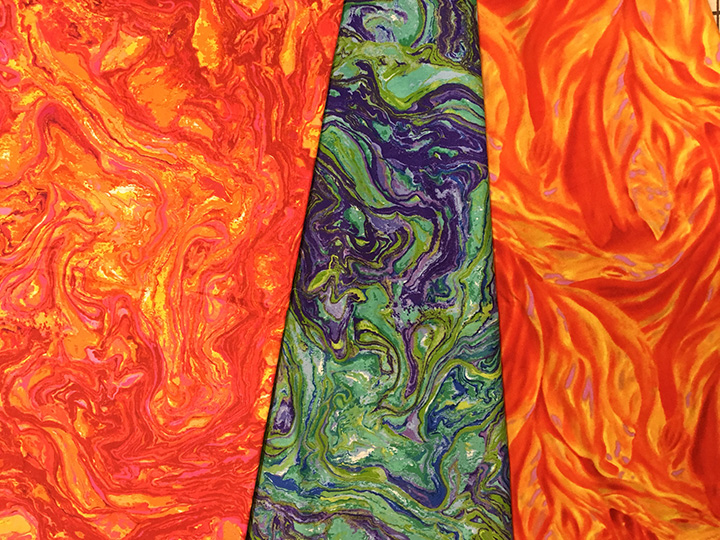
These patterns usually provide a nice variety of curves, repeated patterns, and variations in value to help give form to the images I create. I look for designs in the fabric that I can cut around and use as contours in my image. Such fabric is often able to serve multiple purposes. Long curves for hair or the flowing tail on a fish or air currents across face of a sun could all be from the same fabric.
Scale
A discussion of pattern leads directly into scale. Scale refers to how large the repeated image is. I’m attracted to larger scale prints. Students tend to be hesitant about using them, but I find them more useful that small-scale patterns. If you need a curve, it’s easier to cut one from a large pattern than it is to combine several smaller bits to create that curve.

However, smaller overall designs have their uses as well. I often use them for more subtle blending from one value to the next, such as in a face of a person or the body of an animal. See the photos of the “Cousins” and Kali the dog below.
Quantity
I tell my students variety is more important that quantity. I can and do use hundreds of different fabrics per piece, yet most of my quilts are no bigger than a couple yards total in size.
I typically buy fabrics in half-yard (give or take) increments. Even fat quarters are sometimes enough. When do I buy more? The answer to that question is mostly dependent upon scale—the size of the image repeated within the fabric.

For example, in my quilt “Dixie Dingo Dreaming” I used exclusively aboriginal motif fabrics. Many of those Australian fabrics have large design elements, so large that I usually bought a yard or more of each to ensure that I got enough of those repeated patterns to use in the piece. A few of those fabrics then came in handy for Crocodylus Smylus, an Australian saltwater crocodile, a few years later.
Examples
Sometimes you just have to see something done in order to understand it. I use two of my pieces, “Kissin’ Cousins” and “Golden Temple of the Good Girls” to demonstrate how and where I used particular fabrics.
For scale of the patterns, each fabric swatch is 5 inches wide by 8 inches tall.






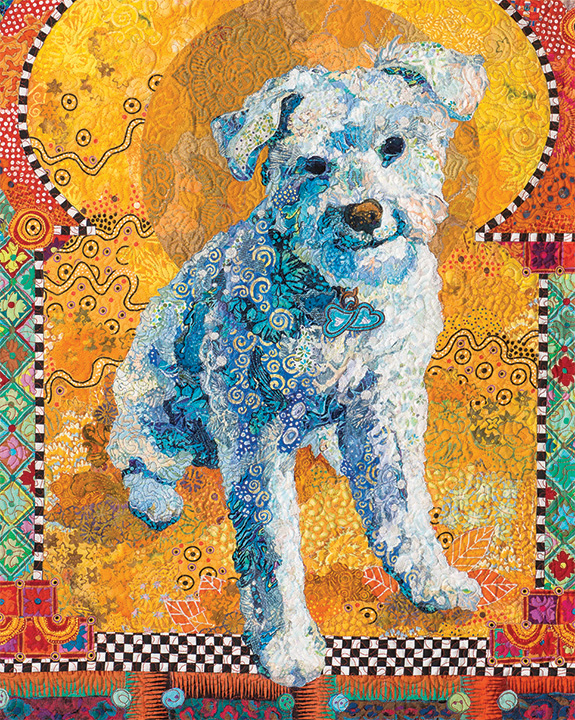


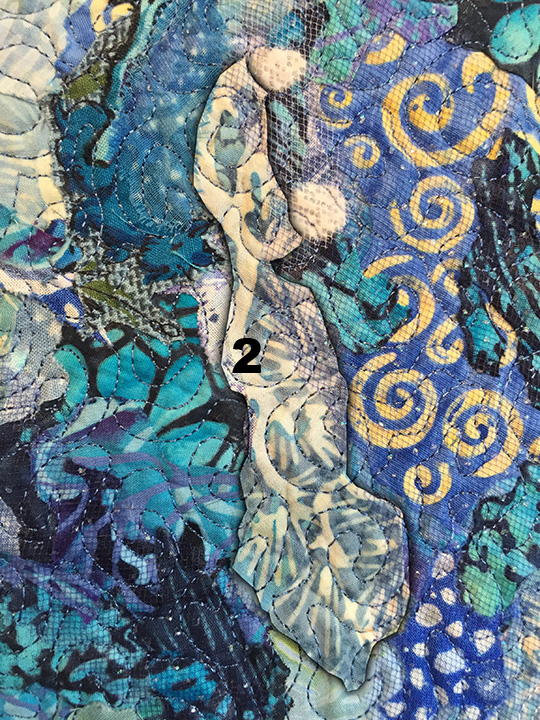


So, there are just a few of the thoughts that go through my head as I’m making fabric choice decisions. I know some students may be looking for hard and fast rules for choosing fabric, but I guess it’s more like guidelines.
First, buy fabric that makes you smile and you feel good about. There’s nothing bad about that. Then supplement with fabric picked specifically for your project, be it because of color, design, or scale. Go for variety. More is better. That’s my motto and I’m sticking with it.
I remain unapologetically eclectic.
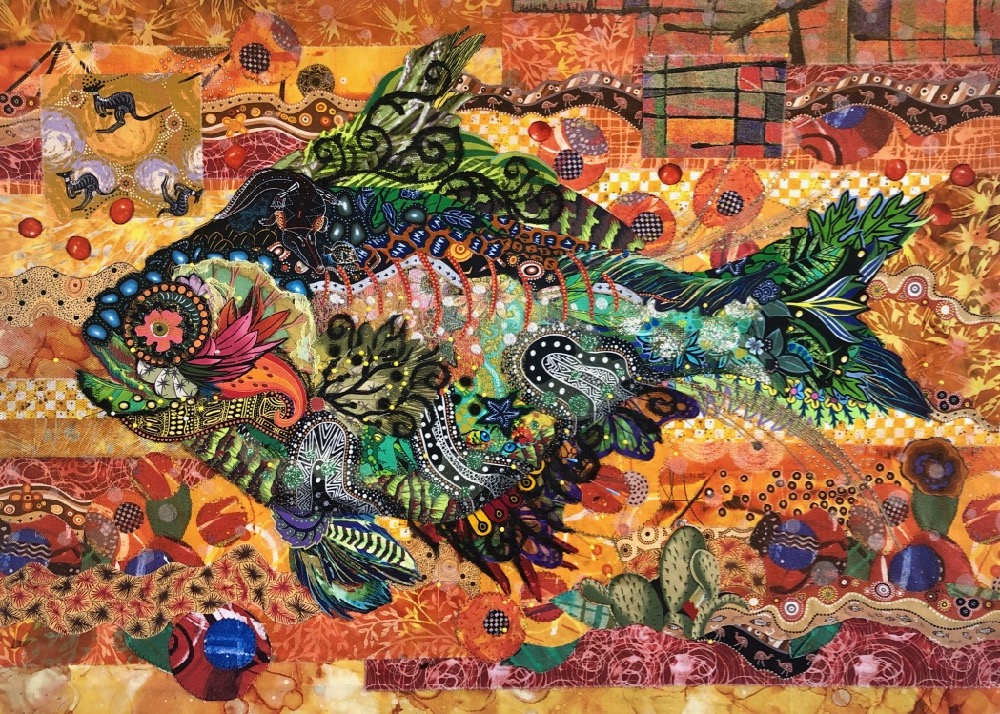
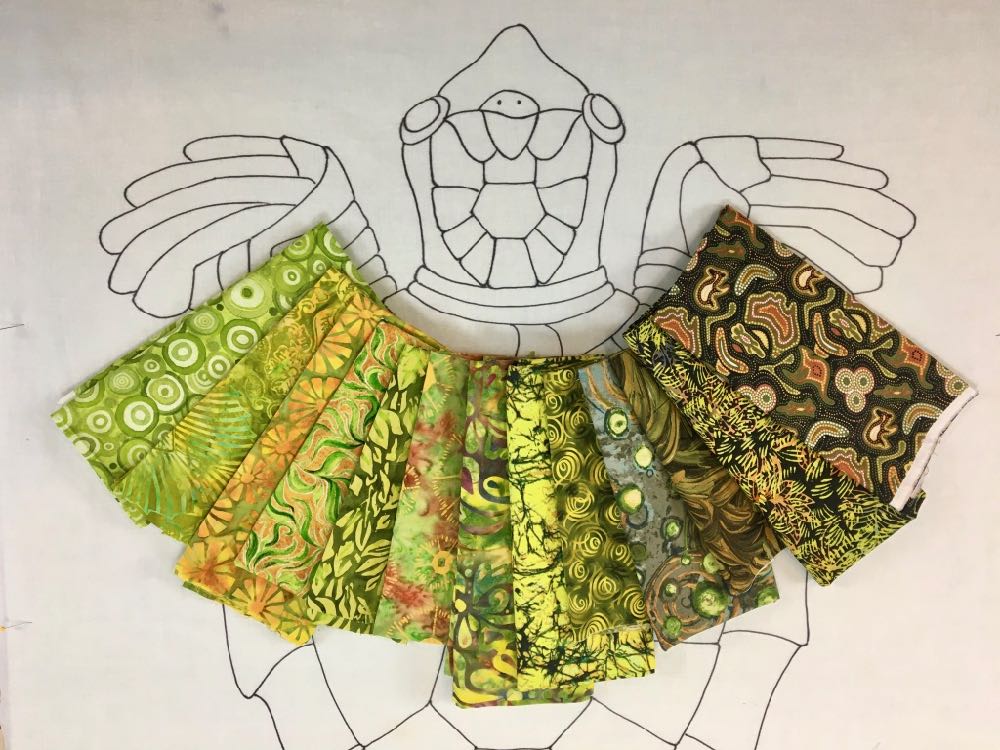
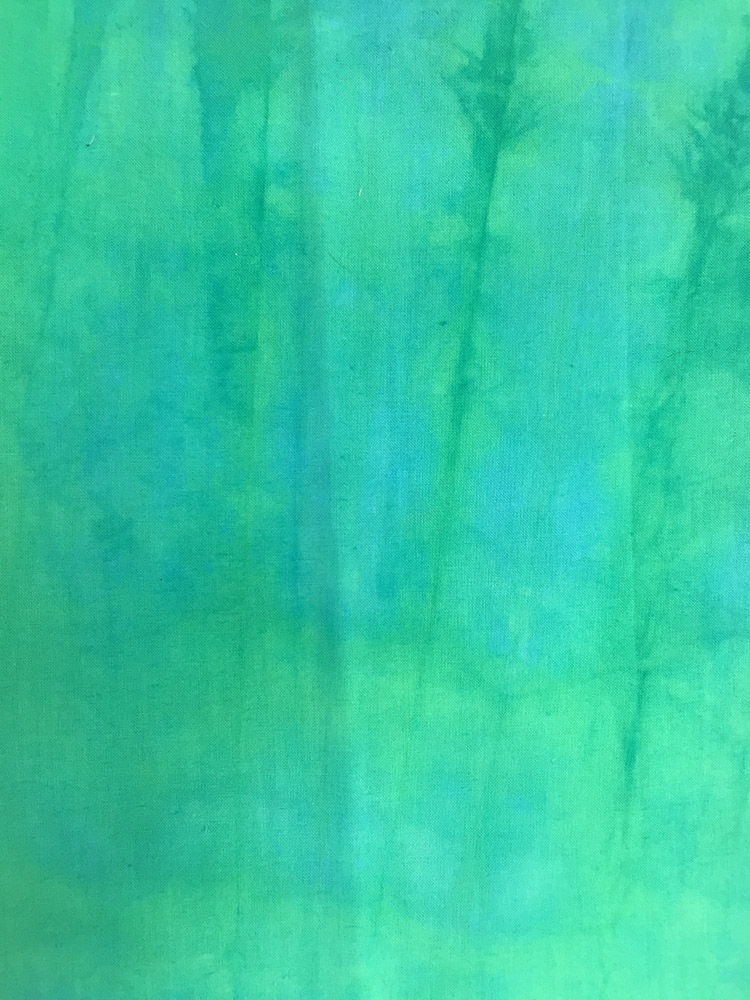
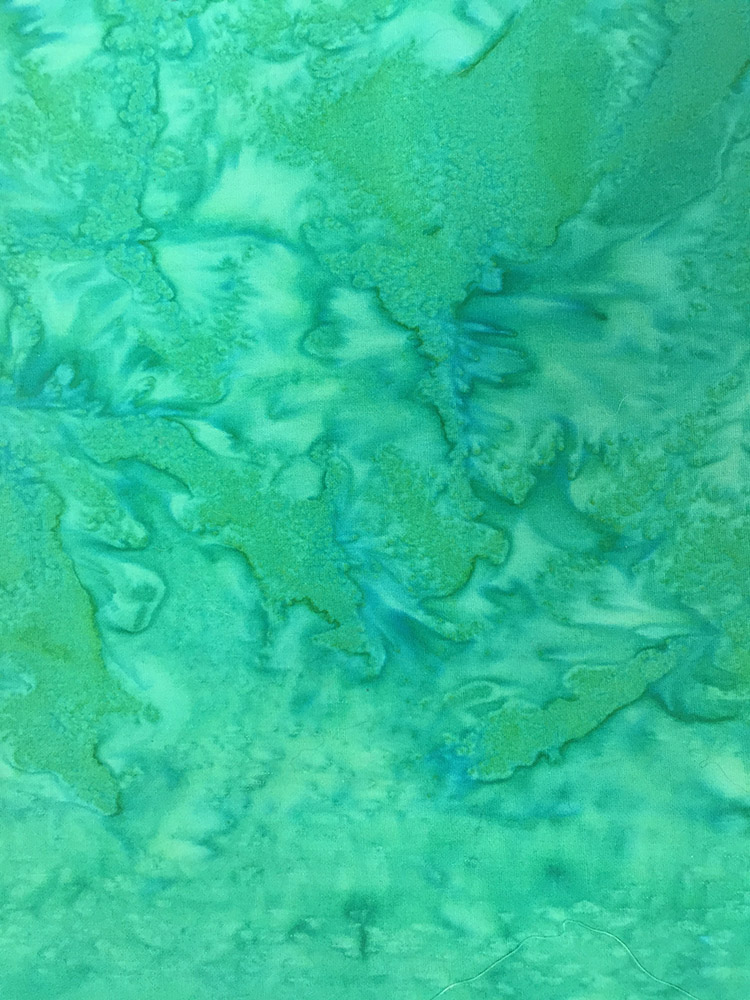
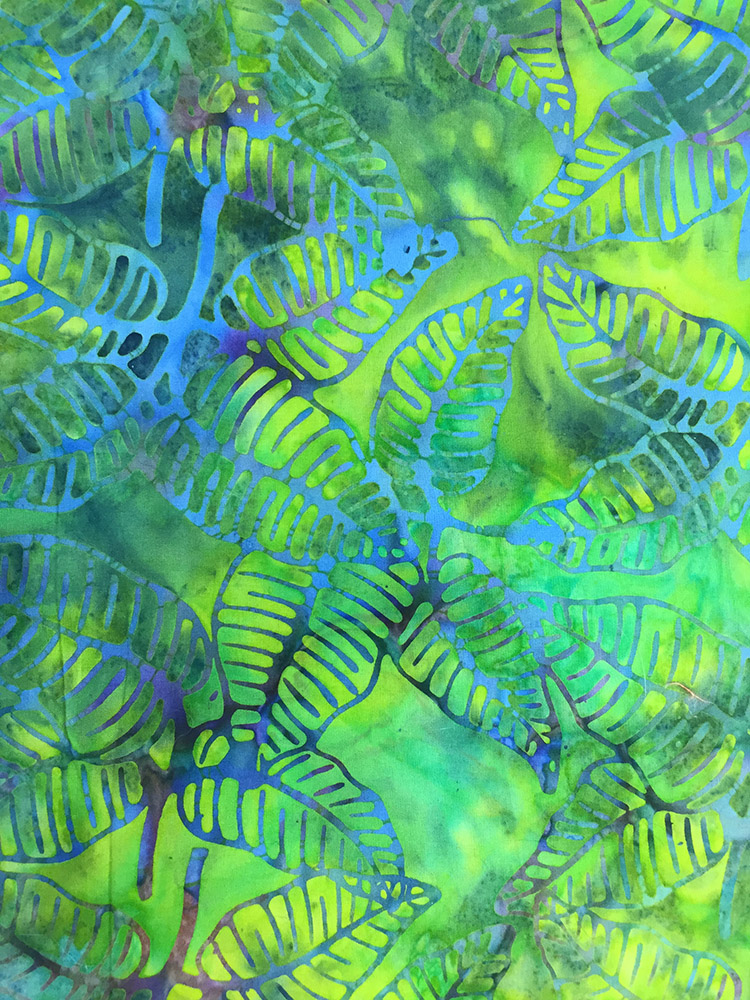
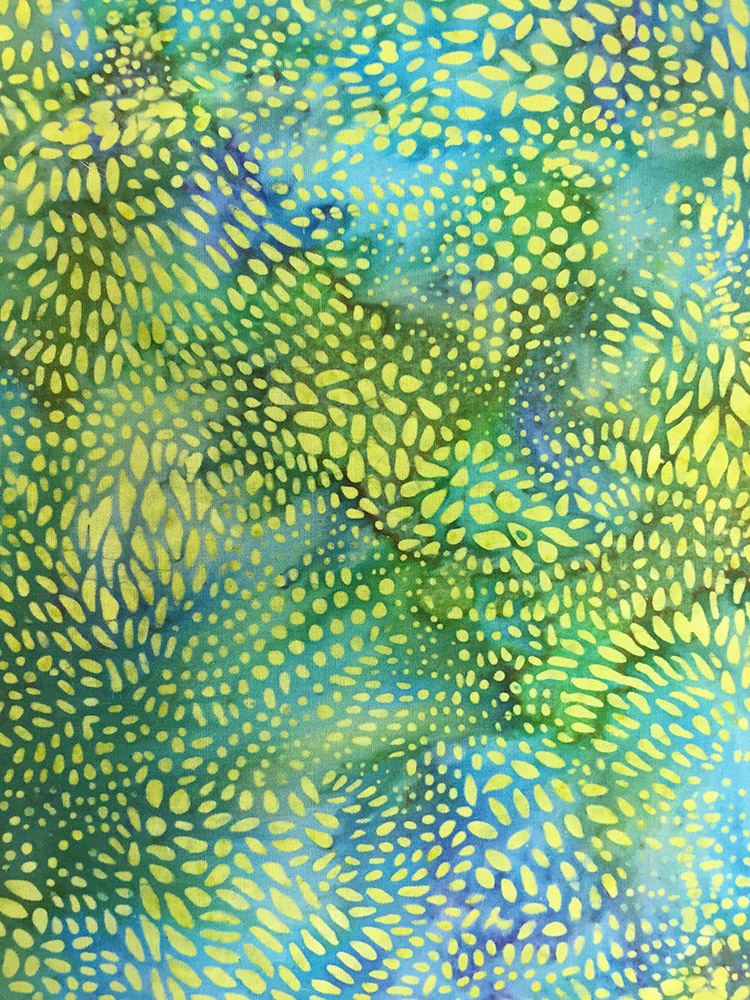
7 Comments